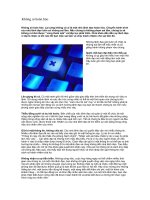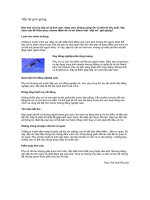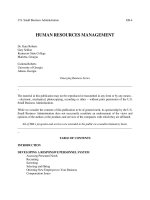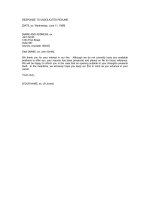Tài liệu E-Human Resource Management 11 docx
Bạn đang xem bản rút gọn của tài liệu. Xem và tải ngay bản đầy đủ của tài liệu tại đây (693.5 KB, 9 trang )
76 Bhattacharya & Huntley
Copyright © 2005, Idea Group Inc. Copying or distributing in print or electronic forms without written
permission of Idea Group Inc. is prohibited.
tional skills. Therefore mapping of the ‘social’ interaction requirements of a job
helps managers learn more about it and may provide critical information that
constitutes the job description of a position, either formal or informal. Data
collection for such information may be periodical, although temporal data is
needed to get a stable pattern for the social aspect of the job.
Job-related information provided by social network mapping can be of several
types. What is the level of interaction requirement of the job in relation to other
jobs/positions at the same or different organizational levels (frequency of
interaction)? Complex interaction patterns would reveal a higher requirement
of people-related skills, while sparse interaction may indicate either technical/
specialized skills or lower skill requirements. Structural holes — that is, the
distance between the network contacts — is also relevant for describing a
position. Are the network contacts far apart or close together? Far-flung
networks may indicate cross-functional interaction requirements, sometimes
across hierarchical levels, while tightly knit networks indicate homogeneous
work groups. Centrality of the position is yet another critical dimension that
indicates requirement for leadership abilities because the incumbent may need
to exercise more decision-making capabilities if most of the contacts in the
network are referring back to this position often. All this information provides
critical input for recruitment and selection processes, and helps in choosing the
‘right’ candidate for a job.
Job-related information provided by social network mapping can be used for
training and development purposes as well — to identify current and future
training requirements for a job. For example, central and critical jobs have
greater requirement for interpersonal training. Effective succession planning, an
emerging critical HRM activity (Burke, 1997), can also benefit from network
information on jobs. Jobs that are more central and critical in a network would
require more planning for succession in case of turnover/retirement of the
current incumbents. Network-based decision support tools may help to set
normative targets for a job used in performance management processes. For
example, transaction alternatives, a dimension of networks, show redundancies
in the system in terms of input to particular individuals and their output to others.
Redundancies need to be optimized because of the trade-off between effi-
ciency (low redundancy) and flexibility (high redundancy). Performance man-
agement processes need to incorporate these trade-offs in their normative
targets for job performance. In yet another function of HRM, employee
relations, identification of central and critical jobs would help in determining
better negotiation strategies, as well as assist in maintaining a harmonious
Social Network Mapping Software 77
Copyright © 2005, Idea Group Inc. Copying or distributing in print or electronic forms without written
permission of Idea Group Inc. is prohibited.
relationship. Management can focus their efforts on these jobs, and achieve
greater efficiency in employee relations. Finally, network information related to
job can also be an input for compensation and benefit management processes.
By measuring the social component of a job, managers get an opportunity to
reliably incorporate the social components in their compensation design.
Information about the Person
Who does an individual interact with? Are they strong or weak ties? Are they
static or dynamic ties? What types of information flow through these ties? Are
there power and status flow through these ties? How can the network determine
performance outcomes? These are some of the questions that can be answered
by social network mapping at the individual level. This information can be an
input for several HRM functions that aim to motivate people to give their best
and to improve productivity and creativity.
For example, different network positions represent different opportunities for
an individual to access new knowledge. An employee’s network position
reveals his/her ability to access external information and knowledge. By
occupying a central position in the intra-organization network, an employee is
likely to access desired strategic resources. Such resources will fuel the
individual’s innovative activities by providing the external information neces-
sary to generate new ideas. If an organization can identify the individuals who
occupy central positions in networks through social network mapping, then
more targeted efforts can be directed towards these individuals in developing
them for greater creativity and productivity.
At the same time, the innovative work of the organization will benefit from direct
access to the knowledge residing in the individual. Knowledge is usually
distributed unevenly within an organization (Ibarra, 1993) because it is difficult
to spread it across different individuals where preexisting relationships among
people are absent. Indeed, innovative ideas are often the result of interaction
among groups and team members. To foster innovation, information and
knowledge should be deliberately distributed. A network of people provides
channels for distributing information and knowledge that as to stimulate and
support innovative activities. Therefore a central network position is associated
with innovation outcomes within an organization (Tsai & Ghoshal, 1998). An
individual occupying a more central position in the network is likely to produce
more innovations.
78 Bhattacharya & Huntley
Copyright © 2005, Idea Group Inc. Copying or distributing in print or electronic forms without written
permission of Idea Group Inc. is prohibited.
Network information that profiles the social capabilities of individuals may be
used for effective selection, for training and development, for matching them
with positions, as well as to grow them within an organization. Effective
utilization of social skills would enable the firm to achieve better productivity.
Fulfillment of social needs of individuals will increase the probability of retention
of the individual. For performance management processes, individuals can be
assessed reliably against normative targets set through established patterns of
interaction. This would be a significant improvement over subjective assess-
ments of organizational and social skills, and may help reduce costs associated
with alternative evaluation processes like 360-degree feedback. In employee
relations activities, identification of central and critical individuals helps man-
agement to focus efforts towards negotiation and harmony. Networks of these
individuals can be reached quickly and effectively through them. Exercise of
control in difficult situations can also be accomplished using their network
leverage. For compensation and benefit management processes, the social
profile of an individual helps managers to identify some of the factors that would
motivate him/her. Therefore, customized compensation and benefits may be
designed to match each individual’s preferences.
Information about Groups
Social network mapping information is most relevant for management of groups
or units within an organization. Although there is an increasing recognition that
groups and teamwork are essential for organizational success, to date we know
little about how to best manage social activities within a group. Network
mapping helps by providing some answers to questions like:
• Is the group formal or informal (compare mapped interactions with
organizational design)?
• Do members of the group change?
• How does the group operate?
• Are interactions frequent or sparse?
• Who occupies the central position, the group leader or somebody else
who is socially more powerful?
• Do most of the interactions within the group occur during projects or do
the social interactions continue in between projects too?
Social Network Mapping Software 79
Copyright © 2005, Idea Group Inc. Copying or distributing in print or electronic forms without written
permission of Idea Group Inc. is prohibited.
Structural holes, which are non-connected distances between contacts in a
network; connectiveness, which refers to whether or not all possible linkages
in an aggregate are being utilized; density, which is the number of relationships
expressed as a proportion of all possible linkages — are some of the main
parameters of network information that are useful for management of groups.
A network showing large structural holes indicates either a less cohesive group
or a diverse group in terms of functional or cultural background. This will impact
the skill demand analysis of the group, selection of members for the group, as
well as culture and consensus-building exercises that can be applied to the
group. Connectiveness is a relative concept, and the optimal level of
connectiveness is different for different groups. Centrality of a group and its
connectiveness, both within the group and with other groups, can provide
significant input for training of the group members. For example, cross-training
is expected to increase connectivity. Similarly, density of interaction may
indicate the homogeneity/heterogeneity of the group culture, which is an
important input for group intervention processes.
Performance management implications of network information of groups are
the most significant. Mapped patterns allow managers the scope to optimize
reachability (how many links a communication must flow through to get from
one node to another) and inclusiveness (number of points that are included
within the various connected parts of the network) for greater efficiency in
communication within groups. This facilitates management of performance by
effective sharing of goals, and by fostering efficient team work. Employee
relations efforts are also aided by improvement of communication channels for
reaching out to groups. Moreover, network information helps management to
identify critical and central groups for negotiation and consensus building. For
compensation management, network mapping helps the management identify
groups, either formal or informal, for whom compensation and benefit pack-
ages should be homogeneous. Research indicates that employee dissatisfaction
arises most from perceptions of inequitable compensation (Mowday, 1991),
compared to referent others in the organization. Network mapping provides
information on who these referent others are so that the cause of dissatisfaction
may be addressed.
Information about Organization
At the organizational level, network mapping provides an overall picture of
network patterns within the organization. Although it may get extremely
80 Bhattacharya & Huntley
Copyright © 2005, Idea Group Inc. Copying or distributing in print or electronic forms without written
permission of Idea Group Inc. is prohibited.
complex and difficult to interpret these networks, there is quite some usefulness
for this information. Apart from showing the social culture of the organization,
network mapping identifies the communication pattern within the organization.
Does the CEO communicate with the managers and the employees? If so, what
is the frequency? What is the pattern of interaction of managers with employ-
ees? Can employees, in general, cross hierarchical, functional boundaries to get
the work done? Is knowledge shared among employees? These are some of
the challenging but critical organizational questions that network mapping can
shed some light on.
Research has already highlighted the significance of intra-unit network ties in
spreading knowledge and best practices (Tsai & Ghoshal, 1998). Organiza-
tional units differ in their internal knowledge, practices, and capabilities.
Networks of inter-unit links allow organizational units to access new knowl-
edge from each other and may increase their cost efficiency through dissemi-
nation of “best practices” within organizations. The centrality and criticality of
a unit in the intraorganizational network may determine the unit’s access to
different knowledge, thus affecting its ability to recognize and respond to new
market opportunities.
The HRM outputs that can be derived from network mapping information at the
organizational level are organizational skill demand analysis for recruitment and
selection, organizational communication patterns for training need analysis,
organizational target setting for performance management processes, balance
between efficiency and flexibility among inter-unit workflow, monitoring of
overall employee relation patterns, and ascertainment of an overall architecture
for compensation and benefit management.
Complementary Network Information
at Difference Levels
Although social network maps can be constructed and analyzed at different
levels within the organization, and the information is useful for individual HRM
processes, the best usage of network data are complementary and symbiotic.
Consistent with the ‘configurational’ approach to HRM (Delery & Doty,
1996), this view is represented diagrammatically in Figure 2. The configura-
tional view proposes that HRM activities are most effective when applied in
Social Network Mapping Software 81
Copyright © 2005, Idea Group Inc. Copying or distributing in print or electronic forms without written
permission of Idea Group Inc. is prohibited.
‘bundles’ where practices are synergistic with each other. We assert that
information from social network mapping can also be applied in ‘bundles’.
Information at the job-, employee-, group-, and organization-level can be used
interactively in HRM decision processes.
Discussion
In this chapter we have discussed a new use of information technology in
management of people: the use of social network mapping software for making
better-informed decisions in HRM. The advent of user-friendly, yet advanced
network mapping software has prompted us to enquire how this software can
provide meaningful information for HRM processes. We have classified the
functionality offered by the software into data collection, descriptive modeling,
and decision support, and have discussed how each of these functions can
provide information relevant to HRM functions. We have identified four levels
of information usage in HRM related to a job, to a person, to a group or unit,
Figure 2. Use of social network mapping information at different levels
Employee
related
information
Job related
information
Organization
related
information
Group related
information
82 Bhattacharya & Huntley
Copyright © 2005, Idea Group Inc. Copying or distributing in print or electronic forms without written
permission of Idea Group Inc. is prohibited.
and to the organization as a whole. For each of these levels, we have explored
how the information obtained from social network mapping can translate into
HRM input and assist in more informed decision making.
The contribution of this chapter lies in opening up a whole new way of looking
at HRM decision making. Traditionally, the informational content for social
processes within an organization is assessed subjectively, through perceptions
of individual managers or supervisors. Social network mapping software
permits a radical change in assessing the social interaction within organizations.
Through visual mapping as well as statistical modeling, the software can provide
precise, relevant quantitative data for the network interactions. We have
explored the intersection of this technology and HRM activities to inquire how
it can assist decision making in HRM.
We feel that such application of social network mapping software would be
especially beneficial for managers at all levels. For the supervisor or HR
manager looking to fill a given position, studying the network interactions of
current or previous holders of that position can greatly aid in selecting
candidates with the “intangibles” desired for success. Similarly, for a manager
investigating the behavior or performance of a particular employee, taking a
snapshot of activity around the employee can greatly aid understanding. At the
group or department level, network models may help to identify synergies or
other strong linkages between the groups. Finally, at the enterprise or organi-
zational level, a survey of the social network may help to explain certain
phenomena discovered through benchmarking studies of other firms. For
example, if a firm is an early adopter of advanced communication technology,
one might expect it to have fewer layers of communication between decision
makers (i.e., improved reachability) which could permit the firm to have a
“flatter” organizational structure.
However, technology is not an end by itself, it is an enabler. By no means do
we imply that technology can replace the human judgment element in decision
making. The applicability of social network mapping software is limited by the
capability of the decision maker. Nonetheless, tools like visualization and
descriptive modeling do make the task easier. The learning curve for using the
software and interpreting the results is relatively low compared to other
extensive database management or knowledge management packages. We can
conclude, therefore, that social network software has the potential to be a
convenient and effective input for HRM processes.
Social Network Mapping Software 83
Copyright © 2005, Idea Group Inc. Copying or distributing in print or electronic forms without written
permission of Idea Group Inc. is prohibited.
References
Burke, W.W. (1997). What human resource practitioners need to know for the
21
st
century. Human Resource Management, 36(1), 71-79.
Burt, R.S. (1992). Structural holes: The social structure of competition.
Cambridge, MA: Harvard University Press.
Delery, J.E., & Doty, D.H. (1996). Modes of theorizing in strategic human
resource management: Tests of universalistic, contingency, and configu-
rational performance predictions. Academy of Management Journal,
39, 802-835.
Granovetter, M. (1973). The strength of weak ties. American Journal of
Sociology, 78, 1360-1380.
Granovetter, M. (1985). Economic action and social structure: The problem of
embeddedness. American Journal of Sociology, 91(3), 481-510.
Ibarra, H. (1993). Personal networks of women and minorities in management:
A conceptual framework. Academy of Management Review, 18, 56-
87.
IKNOW. (2003). Retrieved from iknow.spcomm.uiuc.edu
InFlow. (2003). Retrieved from www.orgnet.com
INSNA. (2003). Retrieved from www.sfu.ca/~insna
Marchese, M.C., & Delprino, R.P. (1998). Do supervisors and subordinates
see eye-to-eye on job enrichment? Industrial and Labor Relations
Review, 51(4), 179-191.
Mowday, R.T. (1991). Equity theory predictions of behavior in organizations.
In R.M. Steers & L.W. Porter (Eds.), Motivation and work behavior
(5
th
edition) (pp. 111-131). New York: McGraw Hill.
NetForm. (2003). Retrieved from www.netform.com
NetVis. (2003). Retrieved from www.netvis.org
SIENA. (2003). Retrieved from stat.gamma.rug.nl/snijders/siena.html
Sparrowe, R.T., Liden, R.C., Wayne, S.J., & Kraimer, M.L. (2001). Social
networks and the performance of individuals and groups. Academy of
Management Journal, 44(20), 316-325.
Tsai, W., & Ghoshal, S. (1998). Social capital and value creation: The role of
intrafirm networks. Academy of Management Journal, 41(4), 464-
476.
84 Bhattacharya & Huntley
Copyright © 2005, Idea Group Inc. Copying or distributing in print or electronic forms without written
permission of Idea Group Inc. is prohibited.
UCINET. (2003). Retrieved from www.analytictech.com/ucinet_5_
description.htm
Uzzi, B. (1996). The sources and consequences of embeddedness for the
economic performance of organizations: The network effect. American
Sociological Review, 61, 674-698.
Wade, M.R., & Parent, M. (2002). Relationships between job skills and
performance: A study of webmasters. Journal of Management Infor-
mation Systems, 18(3), 71-96.









